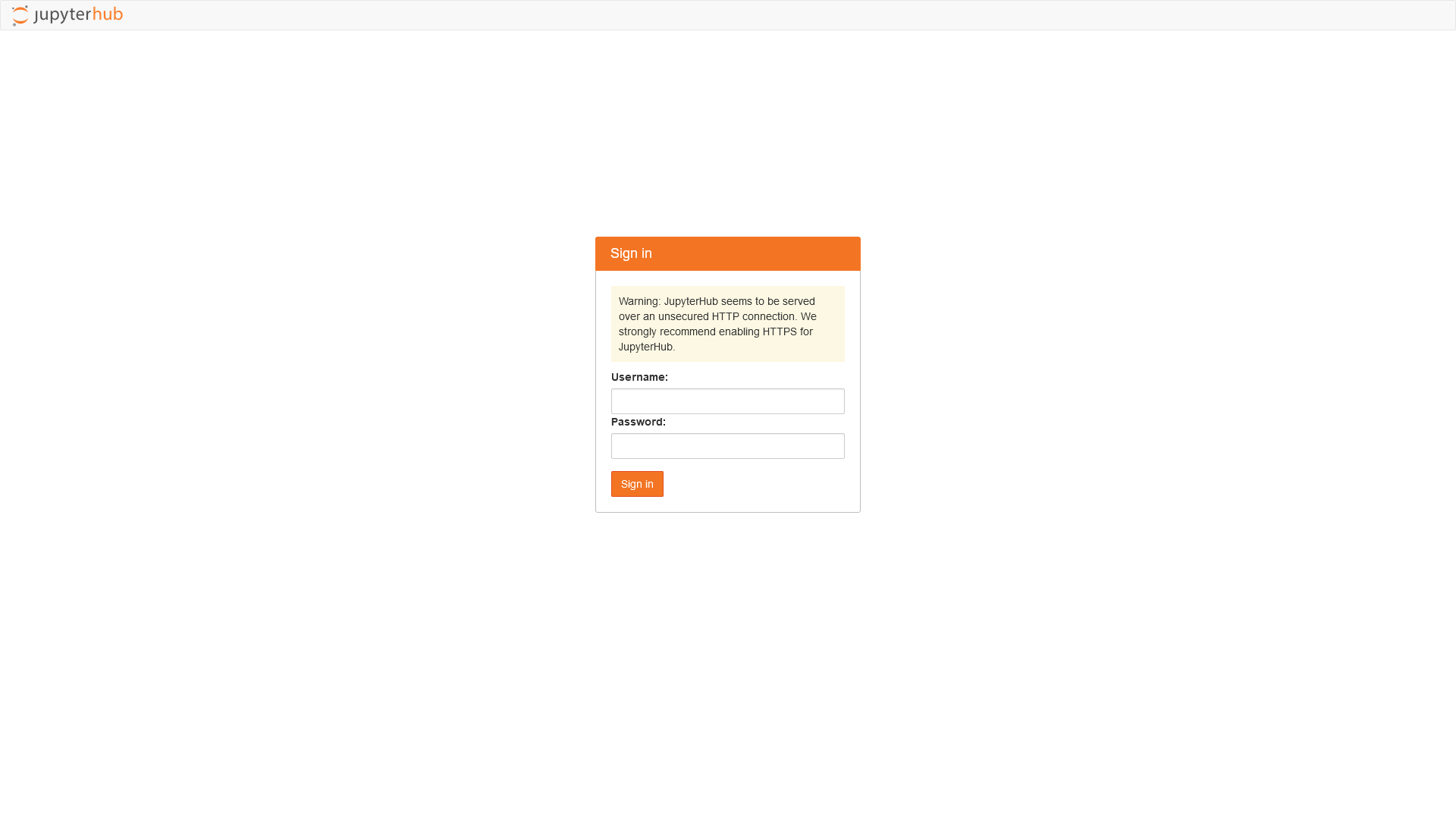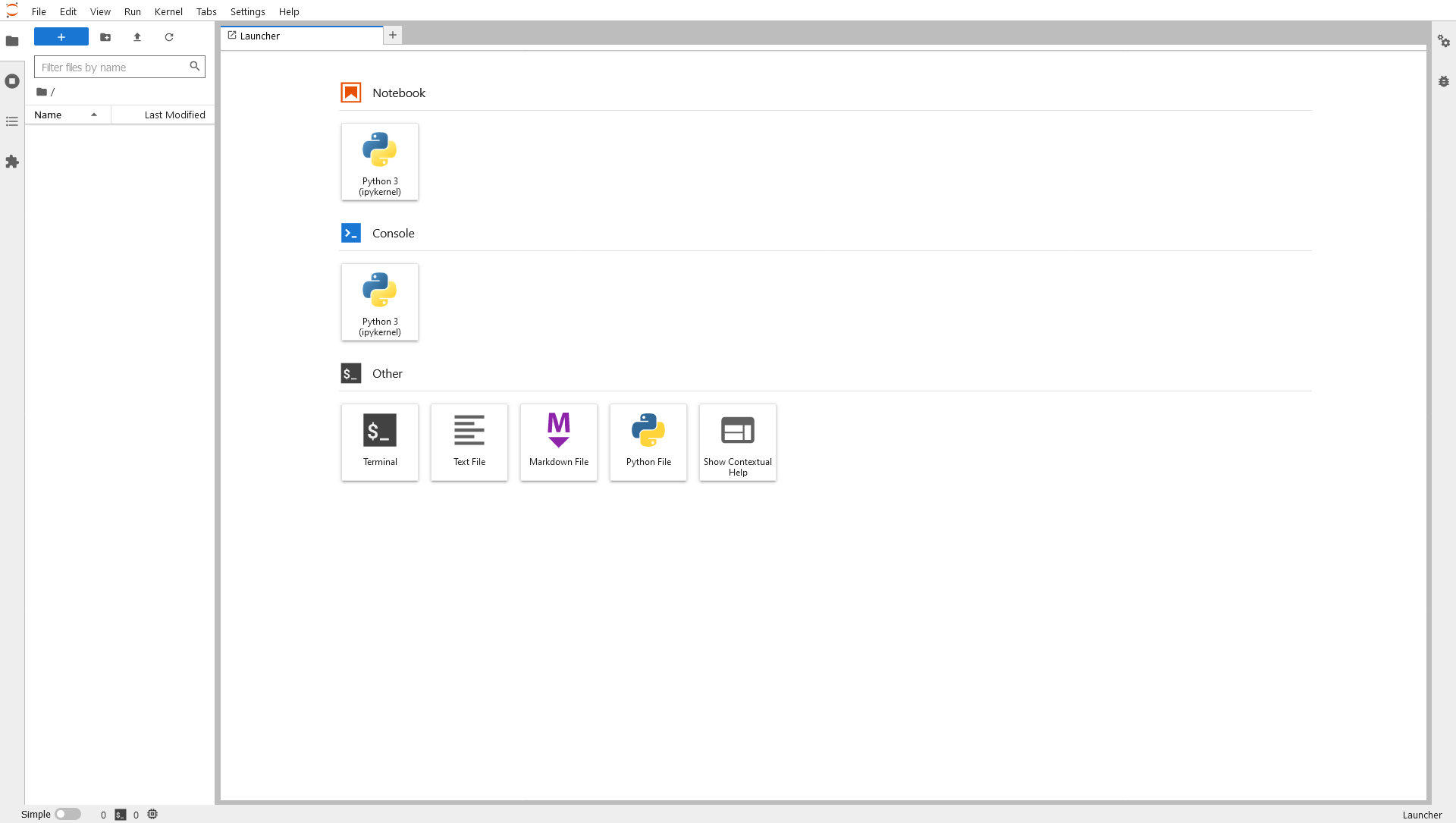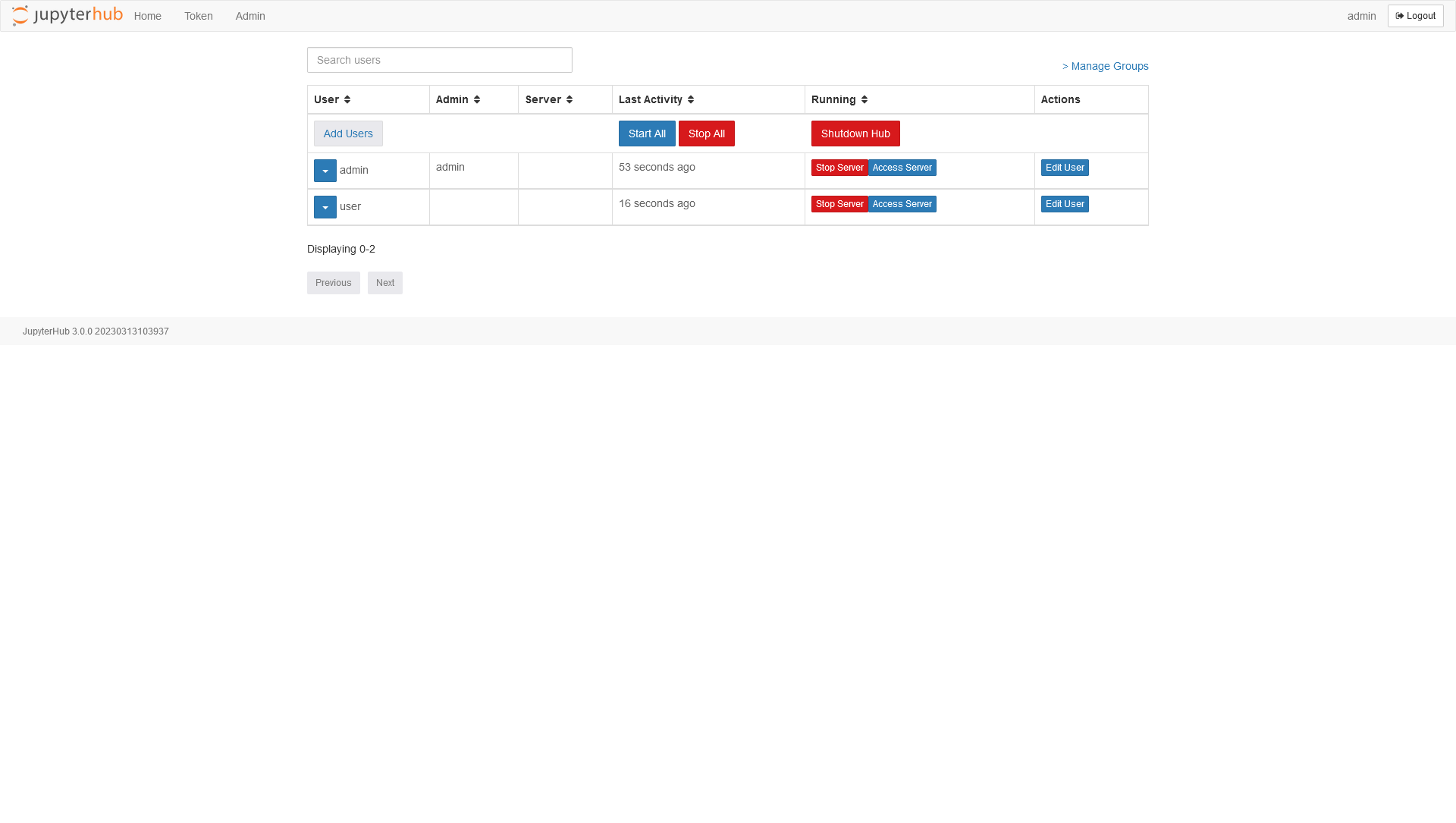5 Deploy a JupyterHub Locally
JupyterHub documentation at https://jupyterhub.readthedocs.io.
Awesome “Zero to JupyterHub with Kubernetes” tutorial at https://zero-to-jupyterhub.readthedocs.io.
mkdir jupyterhubcd jupyterhubCreate the helm configuration file (config.yaml):
# This file can update the JupyterHub Helm chart's default configuration values.
#
# For reference see the configuration reference and default values, but make
# sure to refer to the Helm chart version of interest to you!
#
# Introduction to YAML: https://www.youtube.com/watch?v=cdLNKUoMc6c
# Chart config reference: https://zero-to-jupyterhub.readthedocs.io/en/stable/resources/reference.html
# Chart default values: https://github.com/jupyterhub/zero-to-jupyterhub-k8s/blob/HEAD/jupyterhub/values.yaml
# Available chart versions: https://jupyterhub.github.io/helm-chart/
#Make Helm aware of the JupyterHub Helm chart repository:
helm repo add jupyterhub https://jupyterhub.github.io/helm-chart/"jupyterhub" has been added to your repositorieshelm repo updateHang tight while we grab the latest from your chart repositories...
...Successfully got an update from the "jupyterhub" chart repository
Update Complete. ⎈Happy Helming!⎈Now, install the chart configured by config.yaml:
--version refers to the version of the Helm chart, not the version of JupyterHub, available at https://jupyterhub.github.io/helm-chart/.
helm upgrade --cleanup-on-fail \
--install my-local-jupyterhub jupyterhub/jupyterhub \
--namespace jupyterhub \
--create-namespace \
--version=2.0.0 \
--values config.yamlRelease "my-local-jupyterhub" does not exist. Installing it now.
NAME: my-local-jupyterhub
LAST DEPLOYED: Tue Mar 7 08:36:58 2023
NAMESPACE: jupyterhub
STATUS: deployed
REVISION: 1
TEST SUITE: None
NOTES:
. __ __ __ __ __
/ / __ __ ____ __ __ / /_ ___ _____ / / / / __ __ / /_
__ / / / / / / / __ \ / / / / / __/ / _ \ / ___/ / /_/ / / / / / / __ \
/ /_/ / / /_/ / / /_/ / / /_/ / / /_ / __/ / / / __ / / /_/ / / /_/ /
\____/ \__,_/ / .___/ \__, / \__/ \___/ /_/ /_/ /_/ \__,_/ /_.___/
/_/ /____/
You have successfully installed the official JupyterHub Helm chart!
### Installation info
- Kubernetes namespace: jupyterhub
- Helm release name: my-local-jupyterhub
- Helm chart version: 2.0.0
- JupyterHub version: 3.0.0
- Hub pod packages: See https://github.com/jupyterhub/zero-to-jupyterhub-k8s/blob/2.0.0/images/hub/requirements.txt
### Followup links
- Documentation: https://z2jh.jupyter.org
- Help forum: https://discourse.jupyter.org
- Social chat: https://gitter.im/jupyterhub/jupyterhub
- Issue tracking: https://github.com/jupyterhub/zero-to-jupyterhub-k8s/issues
### Post-installation checklist
- Verify that created Pods enter a Running state:
kubectl --namespace=jupyterhub get pod
If a pod is stuck with a Pending or ContainerCreating status, diagnose with:
kubectl --namespace=jupyterhub describe pod <name of pod>
If a pod keeps restarting, diagnose with:
kubectl --namespace=jupyterhub logs --previous <name of pod>
- Verify an external IP is provided for the k8s Service proxy-public.
kubectl --namespace=jupyterhub get service proxy-public
If the external ip remains <pending>, diagnose with:
kubectl --namespace=jupyterhub describe service proxy-public
- Verify web based access:
You have not configured a k8s Ingress resource so you need to access the k8s
Service proxy-public directly.
If your computer is outside the k8s cluster, you can port-forward traffic to
the k8s Service proxy-public with kubectl to access it from your
computer.
kubectl --namespace=jupyterhub port-forward service/proxy-public 8080:http
Try insecure HTTP access: http://localhost:8080Check the pods:
kubectl --namespace=jupyterhub get podNAME READY STATUS RESTARTS AGE
continuous-image-puller-2nprk 1/1 Running 0 43m
hub-5dd6db89f-vwclm 1/1 Running 0 43m
proxy-5b65d484fb-lp5rl 1/1 Running 0 43m
user-scheduler-dcd8dff75-brpmr 1/1 Running 0 43m
user-scheduler-dcd8dff75-lsscm 1/1 Running 0 43mand the services:
kubectl --namespace=jupyterhub get serviceNAME TYPE CLUSTER-IP EXTERNAL-IP PORT(S) AGE
hub NodePort 10.111.15.143 <none> 8081/TCP 135m
proxy-api ClusterIP 10.107.222.216 <none> 8001/TCP 135m
proxy-public LoadBalancer 10.98.40.47 127.0.0.1 80:30169/TCP 135mIf the external IP is pending, verify that you are running minikube tunnel.
Open JupyterHub by pointing your web browser to http://127.0.0.1.

5.1 Authentication
To use JupyterHub, the user must have a username and password. for testing purposes, we will employ the dummy authenticator. Add
hub:
config:
Authenticator:
admin_users:
- admin
allowed_users:
- user
DummyAuthenticator:
password: "qwerty123"
JupyterHub:
authenticator_class: dummyto config.yaml and restart the cluster by run
helm upgrade --cleanup-on-fail \
--install my-local-jupyterhub jupyterhub/jupyterhub \
--namespace jupyterhub \
--create-namespace \
--version=2.0.0 \
--values config.yamlOpen JupyterHub by pointing your web browser to http://127.0.0.1 and login using user for the username and qwerty123 for the password.

5.2 Clean up
Now you can clean up the resources.
First, stop all servers and shut down JupyterHub using the admin panel at http://127.0.0.1/hub/admin/.

After stop all servers and shut down JupyterHub, you can uninstall JupyterHub.
helm uninstall my-local-jupyterhub --namespace jupyterhubrelease "my-local-jupyterhub" uninstalledminikube delete* Deleting "minikube" in docker ...
* Deleting container "minikube" ...
* Removing /home/raniere/.minikube/machines/minikube ...
* Removed all traces of the "minikube" cluster.